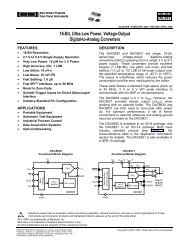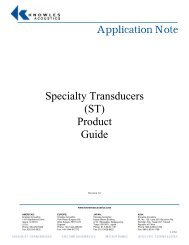AD7714* 3 V/5 V, CMOS, 500 µA Signal Conditioning ADC - dreamm
AD7714* 3 V/5 V, CMOS, 500 µA Signal Conditioning ADC - dreamm
AD7714* 3 V/5 V, CMOS, 500 µA Signal Conditioning ADC - dreamm
Create successful ePaper yourself
Turn your PDF publications into a flip-book with our unique Google optimized e-Paper software.
The SYNC input can also be used as a start convert command<br />
allowing the AD7714 to be operated in a conventional converter<br />
fashion. In this mode, the rising edge of SYNC starts conversion<br />
and the falling edge of DRDY indicates when conversion is<br />
complete. The disadvantage of this scheme is that the settling<br />
time of the filter has to be taken into account for every data register<br />
update. This means that the rate at which the data register<br />
is updated at a 3 times slower rate in this mode.<br />
Since the SYNC input (or FSYNC bit) resets the digital filter,<br />
the full settling-time of 3 × 1/Output Rate has to elapse before<br />
there is a new word loaded to the output register on the part. If<br />
the DRDY signal is low when SYNC returns high (or FSYNC<br />
goes to a 0), the DRDY signal will not be reset high by the<br />
SYNC (or FSYNC) command. This is because the AD7714<br />
recognizes that there is a word in the data register which has not<br />
been read. The DRDY line will stay low until an update of the<br />
data register takes place at which time it will go high for<br />
<strong>500</strong> × t CLK IN before returning low again. A read from the data<br />
register resets the DRDY signal high and it will not return low<br />
until the settling time of the filter has elapsed (from the SYNC<br />
or FSYNC command) and there is a valid new word in the data<br />
register. If the DRDY line is high when the SYNC (or FSYNC)<br />
command is issued, the DRDY line will not return low until the<br />
settling time of the filter has elapsed.<br />
Reset Input<br />
The RESET input on the AD7714 resets all the logic, the digital<br />
filter and the analog modulator while all on-chip registers are reset<br />
to their default state. DRDY is driven high and the AD7714<br />
ignores all communications to any of its registers while the RE-<br />
SET input is low. When the RESET input returns high, the<br />
AD7714 starts to process data and DRDY will return low in<br />
3 × 1/Output Rate indicating a valid new word in the data register.<br />
However, the AD7714 operates with its default setup conditions<br />
after a RESET and it is generally necessary to set up all<br />
registers and carry out a calibration after a RESET command.<br />
The AD7714’s on-chip oscillator circuit continues to function<br />
even when the RESET input is low. The master clock signal<br />
continues to be available on the MCLK OUT pin. Therefore, in<br />
applications where the system clock is provided by the AD7714’s<br />
clock, the AD7714 produces an uninterrupted master clock during<br />
RESET commands.<br />
Standby Mode<br />
The STANDBY input on the AD7714 allows the user to place<br />
the part in a power-down mode when it is not required to provide<br />
conversion results The AD7714 retains the contents of all<br />
its on-chip registers (including the data register) while in<br />
standby mode. When released from standby mode, the part<br />
starts to process data and a new word is available in the data<br />
register in 3 × 1/Output rate from when the STANDBY input<br />
goes high.<br />
The STANDBY input does not affect the digital interface, and<br />
it does not affect the status of the DRDY line. If DRDY is high<br />
when STANDBY returns high, it will remain high until there is<br />
a valid new word in the data register. If DRDY is low when<br />
STANDBY returns high, it will remain low until the data register<br />
is updated at which time the DRDY line will return high for<br />
<strong>500</strong> × tCLK IN before returning low again. If DRDY is low<br />
when the part enters its standby mode (indicating a valid unread<br />
AD7714<br />
word in the data register), the data register can be read while the<br />
part is in standby. At the end of this read operation, the DRDY<br />
will be reset high as normal.<br />
Placing the part in standby mode, reduces the total current to<br />
5 µA typical when the part is operated from an external master<br />
clock provided this master clock is stopped. If the external clock<br />
continues to run in standby mode, the standby current increases<br />
to 150 µA typical with 5 V supplies and 75 µA typical with 3.3 V<br />
supplies. If a crystal or ceramic resonator is used as the clock<br />
source, then the total current in standby mode is 400 µA typical<br />
with 5 V supplies and 90 µA with 3.3 V supplies. This is because<br />
the on-chip oscillator circuit continues to run when the part is in<br />
its standby mode. This is important in applications where the<br />
system clock is provided by the AD7714’s clock, so that the<br />
AD7714 produces an uninterrupted master clock even when it is<br />
in its standby mode.<br />
Accuracy<br />
Sigma-Delta <strong>ADC</strong>s, like VFCs and other integrating <strong>ADC</strong>s, do<br />
not contain any source of nonmonotonicity and inherently offer<br />
no missing codes performance. The AD7714 achieves excellent<br />
linearity by the use of high quality, on-chip capacitors, which<br />
have a very low capacitance/voltage coefficient. The device also<br />
achieves low input drift through the use of chopper-stabilized<br />
techniques in its input stage. To ensure excellent performance<br />
over time and temperature, the AD7714 uses digital calibration<br />
techniques which minimize offset and gain error.<br />
Drift Considerations<br />
The AD7714 uses chopper stabilization techniques to minimize<br />
input offset drift. Charge injection in the analog switches and<br />
dc leakage currents at the sampling node are the primary<br />
sources of offset voltage drift in the converter. The dc input<br />
leakage current is essentially independent of the selected gain.<br />
Gain drift within the converter depends primarily upon the temperature<br />
tracking of the internal capacitors. It is not affected by<br />
leakage currents.<br />
Measurement errors due to offset drift or gain drift can be eliminated<br />
at any time by recalibrating the converter or by operating<br />
the part in the background calibration mode. Using the system<br />
calibration mode can also minimize offset and gain errors in the<br />
signal conditioning circuitry. Integral and differential linearity<br />
errors are not significantly affected by temperature changes.<br />
POWER SUPPLIES<br />
There is no specific power sequence required for the AD7714,<br />
either the AV DD or the DV DD supply can come up first. While<br />
the latch-up performance of the AD7714 is good, it is important<br />
that power is applied to the AD7714 before signals at REF IN,<br />
AIN or the logic input pins in order to avoid latch-up. If this is<br />
not possible, then the current which flows in any of these pins<br />
should be limited. If separate supplies are used for the AD7714<br />
and the system digital circuitry, then the AD7714 should be<br />
powered up first. If it is not possible to guarantee this, then current<br />
limiting resistors should be placed in series with the logic<br />
inputs to again limit the current.<br />
Supply Current<br />
The current consumption on the AD7714 is specified for supplies<br />
in the range +3 V to +3.6 V and in the range +4.75 V to<br />
+5.25 V. The part operates over a +2.85 V to +5.25 V supply<br />
range and the I DD for the part varies as the supply voltage varies<br />
over this range. Figure 5 shows the variation of the typical<br />
2<br />
REV. B –25–















